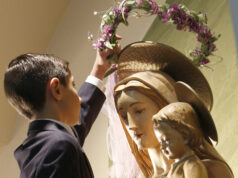
Our oldest son, who just finished kindergarten, loves to visit national parks and participate in their Junior Ranger programs. A few months ago he accompanied me on a trip to Springfield, Ill., where we visited the Abraham Lincoln Home National Historic Site.
That trip inspired an intense interest in the Civil War, and since then he has wanted to learn as much as possible about it, not least through his persistent questions. Not long after our Springfield trip — once he learned that Gettysburg was the bloodiest of the war’s battles, with tragically more than 50,000 dead — he decided we must go there.
[July 1-3 is the 160th anniversary of the Battle of Gettysburg]
I wasn’t exactly sure how to explain the gravity of Gettysburg to our son, much less to our 4-year-old daughter. When it comes to introducing children to history, you are not just dealing with facts and trivia; you’re introducing young minds to the reality of the human condition — that celebrating the greatest of human achievements is good, but that we must acknowledge and recognize the worst of human behavior. Gettysburg, I kept thinking, would be mostly the latter.
Start with why the war was being fought in the first place. Sure, it’s complicated. But we all know we can’t tell the story without the reality of chattel slavery — a concept that is hard enough to comprehend in adulthood, much less when you’re 6. But perhaps my son summed it up best, and succinctly, when he donned a Union soldier’s replica hat at the gift shop and stated: “I want to join in, to make sure people get treated like they should.”
As we made our way through the former combat zone, we frequently tried to grasp the geography of the three days’ battle and imagine what it might have been like to be living in the little borough 160 years ago. But more than that, as we looked at the hundreds of monuments and statues, I wanted to make sure that my kids knew that the Battle of Gettysburg wasn’t all about violence and killing — that it was about giving and loving too.

We stopped and prayed at the statue of Holy Cross Father William Corby — later president of the University of Notre Dame — who personified this. We talked about how he risked his life to serve as a chaplain attached to the Union’s Irish Brigade and how he famously offered general absolution on the second day of the battle.
After taking in Gettysburg, our historical tour continued the next day at the National Shrine of St. Elizabeth Ann Seton in nearby Emmitsburg, Md., where the kids were struck by a simple, lifelike diorama depicting the Daughters of Charity nursing the Gettysburg wounded. Our daughter proudly announced: “That’s what I’d be doing while the cannons blowed up.” Which seemed to be quite a turn-around from the previous day, when she easily spent 15 uninterrupted minutes intensely “loading cannons” on the battlefield.
Over two days, I became grateful for the insights offered by my kids that will help them — and me — continue to process the events of 16 decades ago. When the worst of humanity rears its ugly head, as it will time and again in all of our lives, I hope the important life lessons sharpened by touring Gettysburg and the surrounding environs — the desire to fight for the God-given rights of all, love’s demand to put others first, and the desire to care for those in need — will remain there to guide my kids.
As we encounter and live in a society that continues to cheapen human dignity and where the division is so palpable it feels like we’re battling our own civil wars each day, it’s easy to encounter and focus on the worst of humanity.
But, as sometimes we all need to be reminded through the eyes of the innocent, there is hope. “Where sin increased, grace overflowed all the more” St. Paul wrote to the Romans (5:20). Places like Gettysburg teach that, too, if we put in the work and prayer to make it so. Only then will we be equipped to respond to today’s challenges with a heart of love — with the heart of a child.
Michael R. Heinlein is author of “Glorifying Christ: The Life of Cardinal Francis E. George, O.M.I.” and a promised member of the Association of Pauline Cooperators.
The Dialog provides readers news to your inbox with the Angelus e-newsletter. Sign up here for a free subscription to the Angelus.







